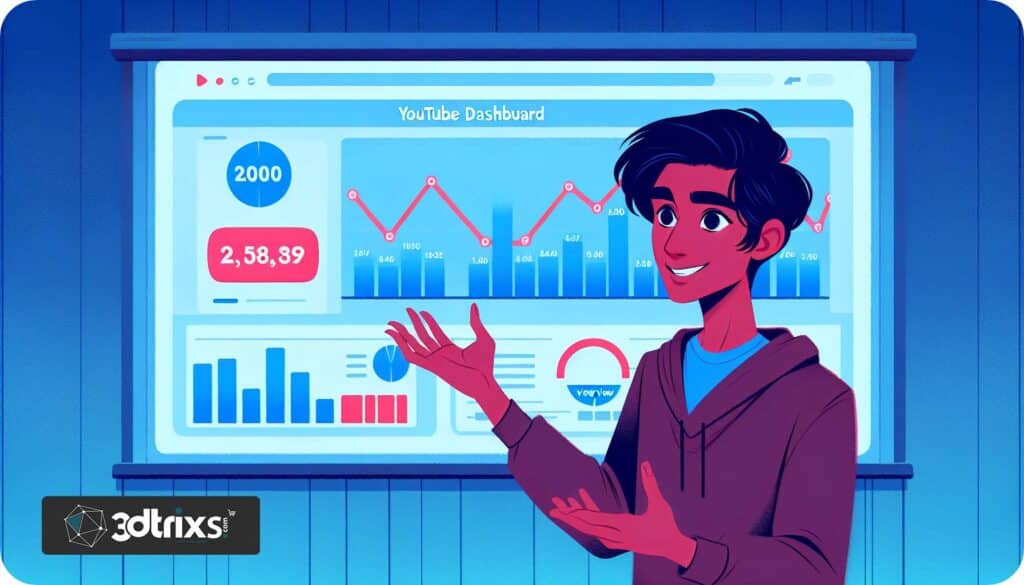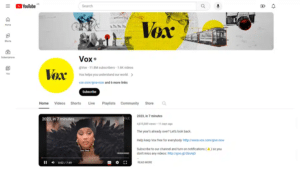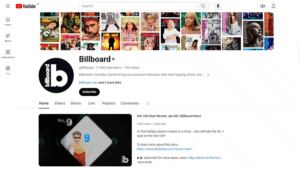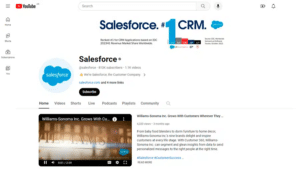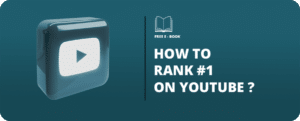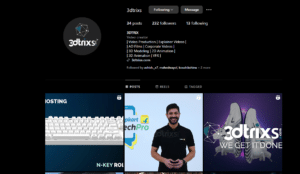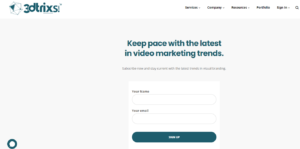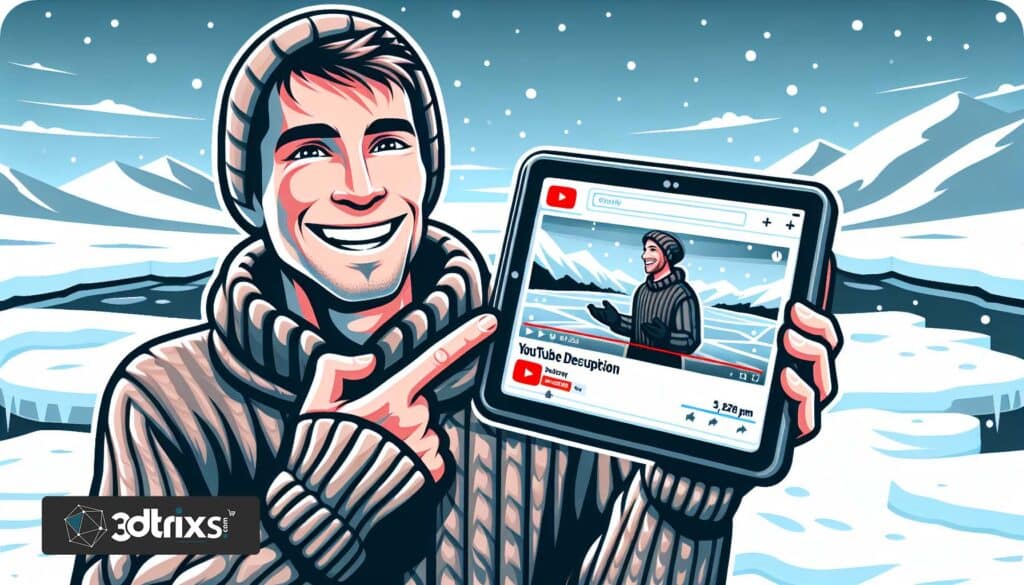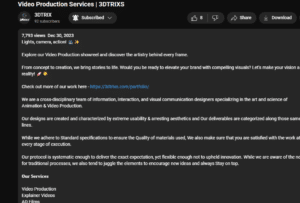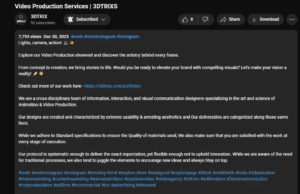YouTube offers an exceptional platform for businesses aiming to engage their audience through video content, but with rising competition, standing out is crucial. As more businesses join the platform, captivating channel visuals become essential for grabbing viewer attention. Understanding the optimal YouTube banner size is the initial step toward achieving this.
For newcomers to YouTube, crafting compelling channel art serves as a prime method to entice viewers, exhibit distinctive brand identity, and encourage subscriptions. This article delves into the precise dimensions of YouTube banners, guides on incorporating them into your profile, and offers exemplary designs for inspiration.
Why Is Your YouTube Banner Size Important?
The YouTube banner, also referred to as the channel header image, serves as a prominent visual element atop your profile. It acts as a representation of your brand, offering visitors an immediate insight into the content you provide, whether it’s engaging advertisements, informative tutorials, or personal vlogs.
A well-crafted banner holds significant value in encouraging visitors to subscribe to your channel. In the competitive landscape of YouTube, distinguishing your channel is essential. A compelling banner enables you to convey your brand’s personality, highlight unique features, and indicate your business priorities effectively.
However, the effectiveness of your banner hinges on proper display. A poorly designed banner can tarnish your brand’s image and deter potential subscribers and viewers. Understanding the correct dimensions for YouTube banner images is crucial in ensuring a visually appealing and impactful presentation.
What Size Is a YouTube Banner on Different Devices
For the ideal YouTube channel banner size, Google provides comprehensive recommendations:
- Upload size: 2560 x 1440 px with a 16:9 widescreen aspect ratio.
- File size: Should not exceed 6 MB.
- Desktop display: Banner dimensions are 2560 × 423 px.
- Tablet display: Banner size is 1855 x 423 px.
- Mobile display: Banners measure 1546 x 423 px.
- Television display: Banner dimensions are 2560 by 1440 px.
- Accepted file formats include JPG, PNG, BMP, and non-animated GIFs.
Don’t worry about the varying sizes! YouTube automatically adjusts your banner’s dimensions based on the device being used to view it.
To ensure your banner always displays correctly, Google suggests keeping essential elements like text or your logo within a “safe area” of 1235 x 338 pixels at the center of your design. This ensures that crucial information remains visible across all devices.
Before uploading your image, you can preview how your YouTube banner size changes across platforms. Let’s explore how to do that!
How to Upload Your Banner to Your YouTube Channel
To upload a new banner image to your channel, navigate to YouTube Studio.
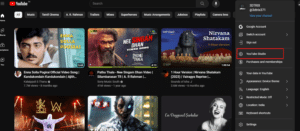
From the left-hand menu, choose “Customization,” then click on “Branding.”
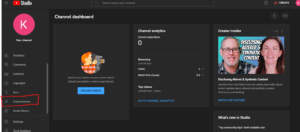
Click on “Change” or “Upload,” and choose the image you want to use as your banner. If necessary, adjust the crop by selecting a preview and making the desired changes, then click “Done.”
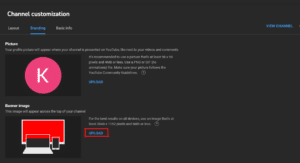
After selecting the image, you’ll be presented with mockups showing how your YouTube header will appear on different devices. If adjustments are needed, you can drag, crop, and resize the image as necessary. Once satisfied with the appearance, click “Publish.”
To add or update your channel art using the mobile app, navigate to your profile and locate the pencil icon to edit your channel’s branding. Next to the banner, select the camera icon, then choose a design from your photos. You can crop the image if desired, and when satisfied, select “Use Photo.”
Great Channel Examples Adapted to YouTube Banner Size Guidelines
That’s quite a bit to take in, so here are three examples to illustrate how these guidelines translate into real-world channel headers that effectively utilize the recommended YouTube banner dimensions.
1 – Vox – Convey Your Company’s Mission
This banner effectively communicates Vox’s identity as a news outlet by featuring newspaper elements and historical innovations like trains. Placing these illustrations within the recommended “safe area” ensures proper display across devices. Beyond adhering to YouTube’s size guidelines, the header also conveys Vox’s mission of keeping audiences informed about global events.
2 – Billboard – Follow Trends
Vox’s banner effectively communicates its identity as a news outlet through a combination of newspaper pieces and historic innovations like trains. Positioned within the designated “safe area,” these elements are optimally displayed across various devices, aligning with YouTube’s size guidelines.
Billboard leverages its extensive collection of colorful magazine covers to create a visually striking YouTube banner. By featuring popular artists such as Bad Bunny, Olivia Rodrigo, and Taylor Swift prominently in the center, Billboard showcases its connection to contemporary music trends.
Creating an engaging YouTube banner involves aligning design elements with the channel’s brand identity and audience preferences. By incorporating eye-catching visuals and relevant content, channels can effectively communicate their message and attract new viewers.
3 – Salesforce – Promote Yourself
Artistic and creative banners can indeed captivate first-time visitors, but your channel art can also serve as a direct promotional tool for your business. Take Salesforce, for instance. They utilized their channel banner to prominently showcase their #1 CRM application worldwide award, effectively leveraging it as a promotional asset.
Embrace the potential of your banner for promotion. By consistently updating it and adhering to the guidelines of YouTube banner size guidelines, it can become a powerful communication tool to engage your audience, share vital announcements, and persuade visitors to explore your product further and make a purchase.
Tips for YouTube Channel Art
Now, W’ve covered the YouTube cover photo size you should use, how to upload it, and provided some eye-catching examples for inspiration. However, starting the design process might be a bit challenging right away.
Here are some recommendations to guide you when designing your channel art, helping you stand out and grab your visitor’s attention at a glance!
Choose the Right Picture
A golden rule in creating banners for YouTube is to choose a design that clearly communicates the subject matter of your channel. Your banner should reflect your identity, so opt for an image that captures your uniqueness and authenticity while aligning with the content you plan to share on the platform.
This could be a compelling photo of yourself, your logo, or an illustration relevant to your content. Ensure it aligns with your business branding for a cohesive look. Incorporating brand elements into your header enhances professionalism, and memorability, and provides visitors with a consistent visual experience.
Add Valuable Information
Banners serve as a means of communication, allowing you to provide visitors with valuable information. For instance, you can showcase your upload schedule to keep viewers informed and build anticipation for new content. Additionally, integrating social media icons into your banner can help promote your presence across various platforms, as long as they fit within the “safe area” of the YouTube banner size.
Previously, YouTube enabled users to include direct links on their banners, but this feature is no longer available. Instead, you can upload up to 14 links in the channel’s “About Me” section. One of our top YouTube description tips is to include links to your social media accounts there. This enables visitors to easily locate and connect with you on other platforms.
Keep It Simple
Ensure your header designs remain simple. Overly cluttered designs risk losing the intended message and may be overlooked.
Google’s YouTube banner size guidelines advise against adding embellishments like shadows, borders, and frames. Since you can’t control how the design will be displayed, some elements may get cut off.
Conclusion
Crafting a header that adheres the guidelines of YouTube banner size guidelines is simpler than it seems. With these tips in mind, mastering the design and size of your headers is within reach.
Customizing your channel art to effectively convey the theme of your videos can lead to quicker subscriptions. Showcase your uniqueness and distinctiveness, and seize the potential of online video marketing on YouTube.
Submit Video Requirement
